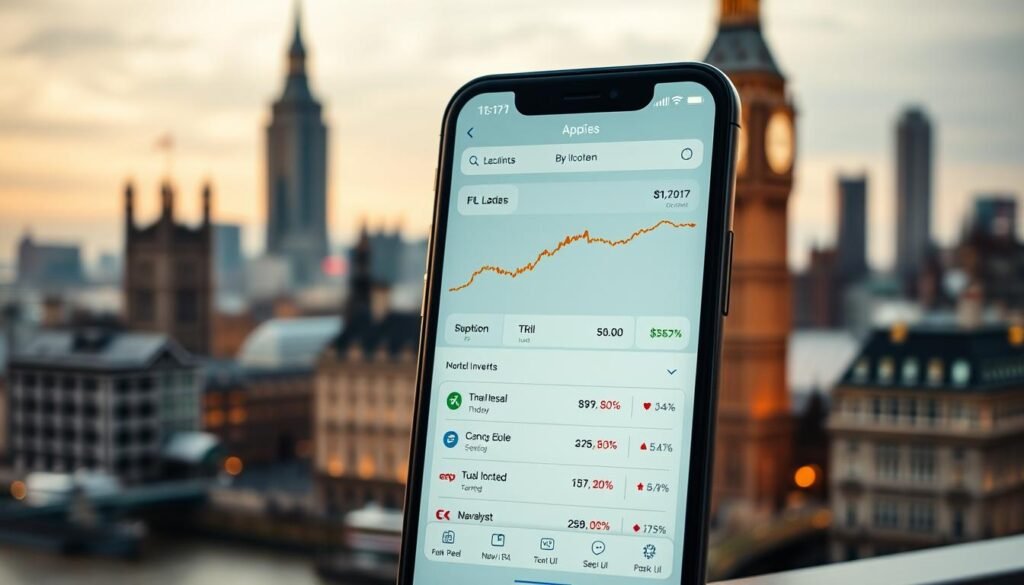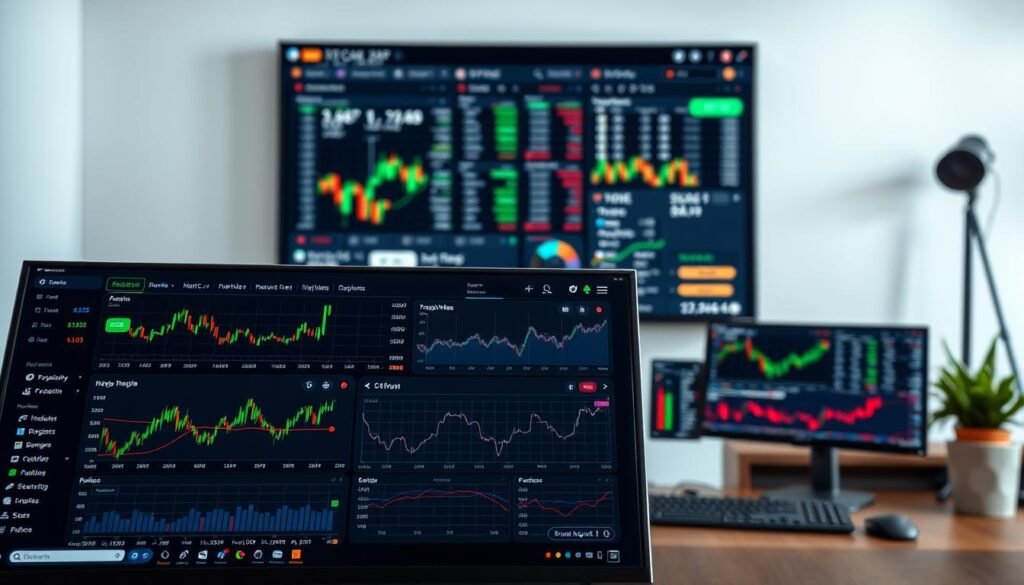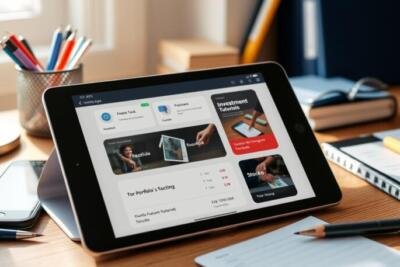
Top Stock Market Apps in the UK for Beginners 2026

Imagine you download an app after a coffee and, within minutes, you buy a slice of a well-known share with just £1. That feeling of control can be thrilling and a little daunting.
You’re not alone if you want clear guidance on trading and simple onboarding. This introduction will guide your first steps and show why a few platforms stand out for low minimums, clear fees and useful learning tools.
Expect concise comparisons so you can weigh features like ISA options, cash interest on uninvested balances and whether fractional buying is supported. We’ll point out where fees hide and what matters for early investment choices.
Start confidently, not rushed. By the end you’ll know which app or platform to try first and how to protect your capital while you learn online trading.
- What you’ll learn about the best trading apps right now
- Editor’s quick picks for beginners
- How we select and rate beginner-friendly platforms
- Trading 212: best overall for first-time investors
- XTB: great for low fees and new ISA option
- AJ Bell: widest range for long-term investing
- IG: best educational app for beginners
- eToro: best social experience and copy trading
- Hargreaves Lansdown: best for account range and service
- Are online trading platforms safe in the UK?
- Understanding trading fees before you open an account
- Taxes for beginners: CGT, dividends and stamp duty
- Choosing the right account: ISA, SIPP and general accounts
- How to open a UK trading account today
- Features beginners should look for
- Regular monthly investing and pound‑cost averaging
- Buying US shares from the UK: what to know
- Other trading platforms we tested and who they suit
- top stock market apps UK beginners: our verdict for the present
What you’ll learn about the best trading apps right now
Before you tap a trade, know what makes one trading platform clearer and cheaper than another.
We tested leading providers on iPhone 15 and Galaxy S23 Ultra and checked real costs. You’ll learn to compare total cost of ownership: dealing charges, custody or platform fees and FX margins when you buy overseas stocks.

We’ll also show how to judge an app’s onboarding, watchlists, basic trading tools and in‑app educational resources. That helps you see if a platform truly supports new investors or just sells a slick interface.
"Look beyond headline offers the small charges you ignore today become big costs later."
You’ll compare UK versus US share dealing, learn why dealing hours and FX matter, and see practical tips on regular investing, fractional shares and recurring buys to build habit.
We’ll flag safety checks and red flags: FCA authorisation, FSCS protection and hidden inactivity or custody fees to avoid costly surprises.
Editor’s quick picks for beginners
Some platforms let you start investing with almost no cash, so your first trade can be a tiny, low‑risk step.
Fastest to start with £1–£0 minimums
You can open and fund quickly with Trading 212 (from £1) or XTB (£0). Both make placing your first order straightforward and keep ongoing fees low. They also pay competitive cash interest on idle balances, which helps while you decide what to buy.
Standout for education, social and low fees
IG’s IG Invest app pairs zero-commission share dealing with an in‑app lessons library for steady learning. eToro offers commission-free shares and copy trading plus a demo account to practise strategies.
- Hargreaves Lansdown suits long-term plans with ISA, SIPP and Junior SIPP options despite higher per-trade charges.
- Choose based on how often you trade; custody or inactivity charges can erode savings from zero commission headlines.

| Platform | Minimum | Key advantage | Notes |
|---|---|---|---|
| Trading 212 | £1 | Free trading, 4.9% cash interest | Good for small recurring buys |
| XTB | £0 | 0% commission, ISA launched Dec 2024 | Low fees, strong cash interest |
| IG | £0 | Education library, Smart Portfolios | Quarterly custody fee unless conditions met |
| eToro | £0 | Copy trading, demo account | Social discovery, research advised |
| Hargreaves Lansdown | £0 | Wide account range (ISA/SIPP/LISA) | Higher per-trade charges for shares |
"Match your pick to your goals: fast start, education-first, social discovery, or long-term account flexibility."
How we select and rate beginner-friendly platforms
Our team follows a strict testing routine to judge how each trading platform performs in real use. We combine hands‑on checks with structured datasets so you get a clear, comparable score for each provider.
Devices and setup: we test on iPhone 15 (latest iOS), Samsung Galaxy S23 Ultra (Android 14) and Chrome on desktop. That ensures charts, quotes and order tickets behave the same on phones and computers.
What we measure: usability, charting, research tools, education quality, product range and real fees. We look at dealing charges, custody or platform fees, FX spreads and any regular investing discounts.

How we weigh results
- We rank platforms with datasets covering costs, order execution and mobile UX that matter to you.
- We check the breadth of shares, ETFs and funds and whether curated lists aid discovery.
- Account options like ISA and SIPP, plus cash interest, get extra attention.
- FCA authorisation and complaint records are verified before a provider is included.
- Our editorial team keeps ratings independent of advertisers to protect your trust.
"We give extra credit to simple onboarding, clear fee disclosures and steady app performance."
Trading 212: best overall for first-time investors
For many new investors, Trading 212 hits the sweet spot of low cost, clear design and wide choice. You can open an account and start investing from just £1, so testing the platform costs almost nothing.
Why it’s beginner-friendly
Free trading with no management fee keeps your ongoing costs low. The app is simple and intuitive, so placing your first trade and tracking performance is quick.
Investment choice and fractional buying
The catalogue covers thousands of global stocks and ETFs. You can buy fractional shares, which means you can own parts of pricey names from only £1.
Fees and FX: what you’ll actually pay
Trading 212 advertises zero commission, but you should factor in small FX costs when you buy overseas stocks. That FX charge is your main variable trading fee.
Cash interest and ISA options
Holding spare cash earns a competitive 4.9% interest, which reduces the cost of waiting to invest. The platform also offers a Stocks & Shares ISA and a cash ISA to help you save tax‑efficiently.
"Overall, Trading 212 balances cost, choice and ease of use, making it a sensible first stop for many people who want to start investing."
| Feature | What you get | Why it matters |
|---|---|---|
| Minimum | From £1 | Low barrier to test trades and build habit |
| Charges | Zero commission; small FX on overseas buys | Keeps recurring costs low; FX affects overseas trades |
| Range | Thousands of stocks & ETFs; fractional shares | Easy diversification, access to high‑price names |
| Cash interest & accounts | 4.9% on idle cash; Stocks & Shares ISA; cash ISA | Earn while you decide; tax‑efficient saving options |
XTB: great for low fees and new ISA option
If you value clear pricing and tax-friendly choices, XTB is a solid option to consider. The platform offers zero-commission share dealing and no management fee, which keeps your trading costs predictable as you learn.
£0 commission and simple pricing
You get 0% commission on shares and ETFs, plus no ongoing management charge. That combination makes regular small trades cheaper and easier to plan.
What the ISA launch means for your taxes
XTB launched an ISA in December 2024. That lets you shelter future gains and dividends from UK tax, so opening an account with an ISA can help keep your returns cleaner over time.
App experience and discovery tools
The mobile app includes thematic filters like Top ETFs and sector trends. These discovery tools help you find ideas without scrolling through thousands of listings.
- Cash rate: 4.75% on uninvested cash helps your balance earn while you decide.
- CFDs: Available but carry higher risk approach with caution.
- Check FX and ancillary charges on international orders so costs match your expectations.
"Straightforward pricing and a clean interface make XTB a cost‑effective investment platform for many people."
| Feature | What you get | Why it matters |
|---|---|---|
| Dealings | 0% commission on shares & ETFs | Lower cost per trade for frequent investing |
| Cash interest | 4.75% on idle cash | Your money works while you research |
| ISA | Launched Dec 2024 | Shelters gains and dividends from tax |
AJ Bell: widest range for long-term investing
If you aim to build a multi-year portfolio, AJ Bell brings a deep menu of shares, funds, etfs and bonds alongside tax-friendly accounts.
Wide product mix: the platform supports individual shares and investment trusts, mutual funds, bonds and a Lifetime ISA for first-home or retirement goals.
Trading costs and regular investing: single share dealing costs £5 per trade, while regular investing drops the charge to £1.50. That makes drip-feeding small amounts much cheaper.
Fund fees: mutual fund trades are free to place and the platform charges 0.25% with a low cap of £3.50 per month on certain accounts. This structure can suit smaller balances.
Dodl is AJ Bell’s simpler app, offering a cheaper, streamlined route if you prefer minimal fuss without losing access to core account types.
"AJ Bell’s balance of depth and clear pricing makes it a strong choice if you want to combine ready-made funds with occasional share picking."
As your investments grow, review the fee mix across accounts and decide whether the platform still fits your plans. Set up regular investing to automate saving and reduce admin over time.
IG: best educational app for beginners
IG’s learning hub helps you move from curious to confident with clear, step‑by‑step lessons.
The IG Invest app combines guided lessons with a broad trading catalogue. You get access to 11,000+ shares and about 2,000 etfs, plus ISA and SIPP options for tax‑efficient saving.
Smart Portfolios or self‑directed? Choose Smart Portfolios for a hands‑off approach. They suit you if you want managed allocation. Go self‑directed to pick individual shares and etfs and use the app’s research and trading tools.
Fees, custody and cash interest
Share dealing is £0 commission on IG Invest, which keeps trade costs low. Note a £24 quarterly custody fee if you make fewer than three trades in a quarter.
The custody fee is waived with three or more trades each quarter, or if you hold £15,000+ in a Smart Portfolio. Cash interest pays 4.5% but you must have at least one open trade in the month to qualify.
"Use the lessons to learn order types and risk before you scale up. That makes your first trades less daunting."
| Feature | What you get | Why it helps you |
|---|---|---|
| Education | Step‑by‑step lessons in the app | Builds core skills and confidence |
| Choice | 11,000+ shares; ~2,000 etfs | Room to grow from simple to advanced investing |
| Costs | £0 commission; £24 custody fee (conditional) | Low trading fees but watch inactivity charges |
| Cash rate | 4.5% (requires one open trade/month) | Earn on idle cash if you stay active |
If you value seeing other investors' moves, eToro offers a community-led way to learn and trade. The platform pairs commission-free shares with a lively social feed so you can watch sentiment and ideas in real time.
Commission-free trades keep your entry costs low. However, eToro’s in-app research is slimmer than some rivals, so you should use external sources before you commit to any investment.
Copy trading and demo account: practice before you commit
Copy trading lets you mirror experienced investors to learn strategies. Treat copied portfolios as lessons, not guarantees, and set your own risk limits.
The demo account helps you rehearse order placement and portfolio balancing without real money. Use it to test routines before opening a live account.
ISA via Moneyfarm and crypto availability
eToro offers an ISA through Moneyfarm, which keeps tax-efficient investing separate from its social features. The platform also provides crypto trading, but remember crypto is volatile and should be a small part of your plan.
"Use watchlists and alerts to track ideas you see socially, then apply your own criteria before you buy."
| Feature | What you get | Practical note |
|---|---|---|
| Share dealing | Commission-free | Low entry cost; check FX and overnight fees |
| Copy trading | Mirror other investors | Good for learning; manage your risk |
| Demo account | Virtual funds to practise | Test orders and strategy before real trades |
| ISA | Provided via Moneyfarm | Tax wrapper is separate from eToro's social features |
| Crypto | Supported | High volatility—limit allocation |
Hargreaves Lansdown: best for account range and service
Hargreaves Lansdown bundles nearly every account type under one login, which helps families and long‑term planners.
You can open a Stocks & Shares ISA, SIPP, Lifetime ISA and Junior SIPP all on the same platform. That makes it simpler to move money between goals and keep records in one place.
The fund range is deep, so you can choose ready‑made options or pick individual funds and shares alongside research and guidance.
When its fee structure works for you
Share dealing costs £11.95 per trade. That fee suits you if you place larger, less frequent orders.
Fund platform charges run at 0.45% annually, and ISA custody for shares/ETFs is capped at £45 a year. Holding shares in a general dealing account avoids a management fee.
As your balances grow, these charges often fall as a percentage of your holdings.
- One place for every account: useful if you manage family or multi‑goal investments.
- Service and research: high quality support and curated funds help with long‑term plans.
- Watch trade size: use disciplined order sizing to reduce fees as a share of each transaction.
"If you prioritise responsive service and comprehensive account coverage, HL’s platform can be worth the premium."
| Feature | What you pay | Who it suits |
|---|---|---|
| Share dealing | £11.95 per trade | Infrequent traders or larger orders |
| Fund platform | 0.45% pa | Fund investors seeking research and choice |
| ISA custody cap | £45 pa | Holders with larger ISA portfolios |
| General dealing | No management fee for shares/ETFs | Active self-directed investors |
If you want to compare how HL stacks up against low‑cost options, see our guide to the best trading platform for beginners to pick what fits your goals.
Are online trading platforms safe in the UK?
Start by checking a provider’s authorisation and how it holds client assets. That simple step tells you whether a firm follows rules and separates your money from its own.
How the regulator protects you
Only use firms authorised by the Financial Conduct Authority. The FCA sets standards for how firms treat clients and how they keep client money safe.
If a firm misbehaves, you can follow its complaints process and, if needed, ask the Financial Ombudsman Service to review your case.
FSCS compensation and custody arrangements
The FSCS may repay up to £85,000 if a platform fails and owes you money. Market losses are not covered and some products are excluded, so read the small print.
Many platforms hold client assets in trust or segregated accounts. This is designed to protect your holdings if the firm becomes insolvent.
| Protection | What it covers | How it helps you |
|---|---|---|
| FCA authorisation | Regulatory oversight of conduct and client money | Confirms the firm is allowed to offer trading services |
| FSCS | Compensation up to £85,000 for eligible claims | Backs cash claims if the platform fails (not investment losses) |
| Custody/segregation | Client assets held separate from firm funds | Reduces risk your investments are used by the firm |
| Financial Ombudsman | Independent dispute resolution | Last‑resort path if the firm won’t resolve a complaint |
Do your homework before opening a trading account: check the FCA register, read custody and compensation notes, and only proceed when you are satisfied with the platform’s protections.
Understanding trading fees before you open an account
Small charges add up fast; check what a provider really costs for the trades you plan to make. Start by listing expected costs so you can compare platforms on a like‑for‑like basis.
Per‑trade dealing can range from £0 to about £12. Some platforms cut that to £1–£1.50 for regular monthly investing. Also check platform or custody fees: these may be a flat amount or a percentage (commonly 0.25%–0.45% pa) and can be tiered or capped.
Foreign exchange fees on US and overseas stocks
FX fees typically sit around 0.5%–1.5% on non‑sterling trades. If you buy US stocks often, that cost quickly adds to your effective round‑trip trading fees. Consider platforms with multi‑currency balances if you trade in USD regularly.
Buy‑sell spreads and how they affect costs
The buy‑sell spread matters, especially on quick trades. Liquid blue‑chip shares usually have tight spreads; small caps can be much wider and erode short‑term returns.
Other charges: inactivity, telephone dealing, withdrawals
Read the tariff sheet for inactivity fees, telephone dealing charges and withdrawal costs, especially for foreign currency withdrawals. These extras can turn a cheap trading platform into a costly one if you rarely trade or use phone support.
"Build a simple cost model for your expected activity that clarity helps you pick the right trading account."
| Charge type | Typical range | Why it matters |
|---|---|---|
| Dealing per trade | £0 – £12 | Affects frequent traders most; regular investing discounts can reduce this |
| Platform / custody | 0.25% – 0.45% pa or flat | Ongoing charge that grows with portfolio size and can be tiered or capped |
| FX margin | 0.5% – 1.5% | Adds to cost of buying overseas stocks and ETFs |
| Buy‑sell spread | Variable (tight for FTSE 100; wider for small caps) | Impacts short‑term trades and liquidity costs |
| Other fees | Inactivity, telephone, withdrawal | Can surprise low‑activity investors or those using phone support |
Taxes for beginners: CGT, dividends and stamp duty
Taxes matter for everyone who trades or holds investments. A little planning helps you keep more of your returns and avoid surprises when you sell or collect income.
Capital gains rules and current allowances
When you sell shares or funds for a profit, you may owe capital gains tax if your total gains exceed the annual allowance. For 2025–26 the allowance is £3,000. Gains above this threshold can be taxed, so track disposals across your accounts and consider spreading sales across tax years if that suits your goals.
Dividend income and tax-free thresholds
Dividends carry their own allowance. The dividend allowance is £500 in the current tax year. Dividends above this level may be taxed according to your income band.
ISAs and SIPPs shelter dividends and capital gains from UK tax, so using these wrappers for long‑term saving usually makes sense.
Most UK share purchases incur Stamp Duty Reserve Tax at 0.5%. You’ll normally see this added to trade confirmations. Overseas stocks and some ETFs are typically exempt from SDRT, but check the trade receipt to be sure.
"Keep clear records of purchase prices, sales and fees across platforms to calculate gains accurately."
- Record buys, sells and fees multiple platforms complicate calculations.
- Funds and ETFs can pay distributions or accumulate; check which applies.
- Tax rules change: review HMRC updates and seek advice if your situation is complex.
Choosing the right account: ISA, SIPP and general accounts
Picking the correct account is one of the best early decisions you can make. The wrapper you choose affects tax, access to cash and how much you pay in fees. Match your time horizon and goals to the account that suits them.
Tax-efficient wrappers and who they suit
ISAs shelter gains and dividends from UK tax and allow up to £20,000 per tax year across permitted ISA types. They are ideal if you plan long‑term investing and want simple, tax-free growth.
SIPPs add pension tax relief on contributions, which can boost retirement savings. However, your money is locked until pension‑age rules allow withdrawals, so use a SIPP for retirement-focused plans.
When to use a general dealing account
A general dealing account gives total flexibility and no contribution limits. Use it when you’ve filled ISA allowances or need access to cash without pension restrictions. Remember, gains and dividends here are taxable.
Compare fees by account type: some platforms charge different custody or management fees for ISAs, SIPPs and general accounts. Check how each trading platform prices accounts so you avoid surprises.
"Start with an ISA for simplicity and tax efficiency, then add a SIPP when you lock in retirement goals."
| Account type | Main benefit | When to choose |
|---|---|---|
| Stocks & Shares ISA | Gains and dividends tax-free (up to £20,000) | Building a long-term, simple investment plan |
| SIPP | Pension tax relief on contributions | Retirement-focused saving with delayed access |
| General dealing | Flexible contributions and withdrawals | Extra investing after ISA limit or short-term needs |
Practical tips: hold diversified funds or ETFs inside wrappers to reduce single-stock risk, check cash interest rates per account type, and review your account mix at least once a year.
If you want a quick read on how different trading accounts compare, see this useful guide on the best trading platform for beginners to match an investment platform to your aims.
How to open a UK trading account today
Opening an online trading account is quicker than you think — most platforms verify you in roughly ten minutes.
ID checks, National Insurance number and funding
Start the application on your chosen platform and have your National Insurance number ready. You will also need photo ID such as a passport or driving licence for automated checks.
Electronic ID checks speed the process. Once you pass them, verification is usually immediate and you can move to funding.
Bank transfer vs debit card and first trade steps
You can fund most accounts instantly with a debit card or use a bank transfer. Bear in mind bank transfers may take longer if you want to place trades the same day.
After your account is verified and funded, search by company name or ticker, review the order ticket and submit. Start with a small test order to confirm quotes, fees and settlement.
- Enable two‑factor authentication in the app to secure your account.
- Add a watchlist of shares and ETFs to track ideas before committing more capital.
- Use demo mode if the platform offers one to practise without risk.
- Keep brief notes on timing, fees shown and what worked for future reference.
"A small, careful first trade teaches you the mechanics without risking much capital."
Features beginners should look for
The right mix of education, alerts and simple order types turns casual browsing into steady investing. Look for features that teach you, help you track ideas and protect your capital as you learn.
Educational resources, research and watchlists
Clear lessons and in‑app research let you learn concepts before you place a trade. IG’s structured lessons are a strong example of this approach.
Watchlists and curated lists keep potential buys visible. Use alerts to avoid constant checking and to act only when your criteria match.
Fractional shares let you buy small slices of big names; Trading 212 allows purchases from £1. Recurring buys automate pound‑cost averaging into ETFs or shares.
Check how the app displays alerts and whether recurring trades carry extra fees.
Stop losses, order types and risk controls
Choose a platform that supports limit, stop and stop‑limit orders. These basic trading tools help you set execution prices and limit losses.
Start simple: use one control at a time, test it with a small investment, then add layers as your confidence grows.
"Prioritise education and tools that match your plan they reduce mistakes and make investing repeatable."
Regular monthly investing and pound‑cost averaging
Committing a small sum each month makes investing less emotional and more automatic. Many UK providers let you set up scheduled buys from around £25, so you can start without a large lump sum.
Why £25-£50 per month can build discipline
Start small to build habit: setting £25–£50 monthly helps you spread buys across cycles and reduces timing risk. Regular investing smooths volatility through pound‑cost averaging, so you buy more when prices fall and less when they rise.
Lower costs and better allocation: many platforms offer discounted or zero dealing fees for scheduled orders, which keeps transaction costs down for small buys. Funds and ETFs are ideal for monthly plans, giving instant diversification as your investment grows.
Make it automatic: align contributions with payday and review allocations quarterly. If your platform or app supports recurring share purchases, combine them with alerts so you stay informed without over‑trading.
"Consistency beats timing small amounts compound over years."
Practical tip: hold your monthly plan in an ISA to shelter gains and reassess contributions each year to accelerate progress toward your goals.
If you want US stocks in your portfolio, a few admin steps and FX checks make a big difference to outcomes.
Tax and paperwork: before you trade US-listed shares, complete a W‑8BEN form. It typically cuts dividend withholding from 30% to 15% for eligible securities and lasts for three years. Fill it in early so dividends are taxed correctly.
Currency and costs: platforms usually convert sterling to dollars when you buy. Expect FX margins of about 0.5%–1.5%, which can add up if you trade often. Some providers also charge higher dealing fees for overseas orders, so check the tariff before you place a buy sell order.
Dealing hours, orders and record keeping
US market hours and liquidity differ from the London trading day. Be aware of earnings calendars and bigger moves around US sessions.
Use limit orders to control execution, and watch buy‑sell spreads on thinly traded ADRs. Keep purchase records in both USD and GBP so your performance and tax reporting stay accurate.
"Currency swings can amplify or offset stock moves treat the FX element as part of your investment decision."
| Issue | What to check | Practical tip |
|---|---|---|
| W‑8BEN | Reduces dividend withholding to 15% (valid 3 years) | Submit before your first US dividend to avoid excess withholding |
| FX & conversion | Typical margin 0.5%–1.5% | Compare platforms for better FX rates or multi‑currency balances |
| Hours & execution | US sessions differ from LSE; liquidity varies | Use limit orders and monitor earnings to avoid volatile fills |
Other trading platforms we tested and who they suit
If you want different blends of fees, research and account choice, these providers are worth a look. Below is a quick guide to help you match a platform to your plan and trading style.
Barclays Smart Investor
Wide range and flat fees suit mid-size portfolios. The app works best if you already bank with Barclays; some features link to a current account.
Capital.com and CMC Invest
Capital.com focuses on CFDs, so you don’t hold direct shares and long-term investors may prefer another platform.
CMC Invest offers low fees and cash interest. It’s promising but still adding features you might expect from mature platforms.
Fidelity, Freetrade and Vanguard
Fidelity gives thousands of funds and strong research, plus advice if you want it.
Freetrade offers commission‑free dealing; note the ISA charge of £4.99/month which can erode returns on small balances.
Vanguard keeps costs very low but only offers Vanguard funds and ETFs rather than individual share dealing.
- High bank fees: Halifax and Lloyds charge around £11 per UK share trade simple, but pricey for small orders.
- Advanced tools: Interactive Brokers and Saxo give global access and professional tools, but they can overwhelm you at first.
- Flat‑fee value: interactive investor suits larger portfolios; small balances may pay more versus percentage-based rivals.
| Platform | Best for | Key note |
|---|---|---|
| Barclays | Mid-size portfolios | Flat fees; app limited without bank link |
| Capital.com | CFD traders | No direct share ownership |
| Fidelity | Research & funds | Advice available |
"Match your choice to how you plan to trade, the fees you can afford and the markets you want to reach."
top stock market apps UK beginners: our verdict for the present
Our verdict for the present is practical: match a trading platform to how you invest, not to a headline.
For a fast, low‑cost start choose Trading 212 for £1 minimums, free trades and 4.9% cash interest. XTB’s zero‑commission dealing and new ISA make it a serious option for tax‑aware savers. IG is best if you want lessons and guided Smart Portfolios. eToro also offers copy trading and a demo to practise, while Hargreaves Lansdown gives a wide range of accounts as balances grow.
Keep fees under control, understand FX and avoid inactivity charges. Above all, use education and diversification your capital is at risk, so make measured investment decisions and invest steadily.
If you want to know other articles similar to Top Stock Market Apps in the UK for Beginners 2026 you can visit the category Investing.






Leave a Reply